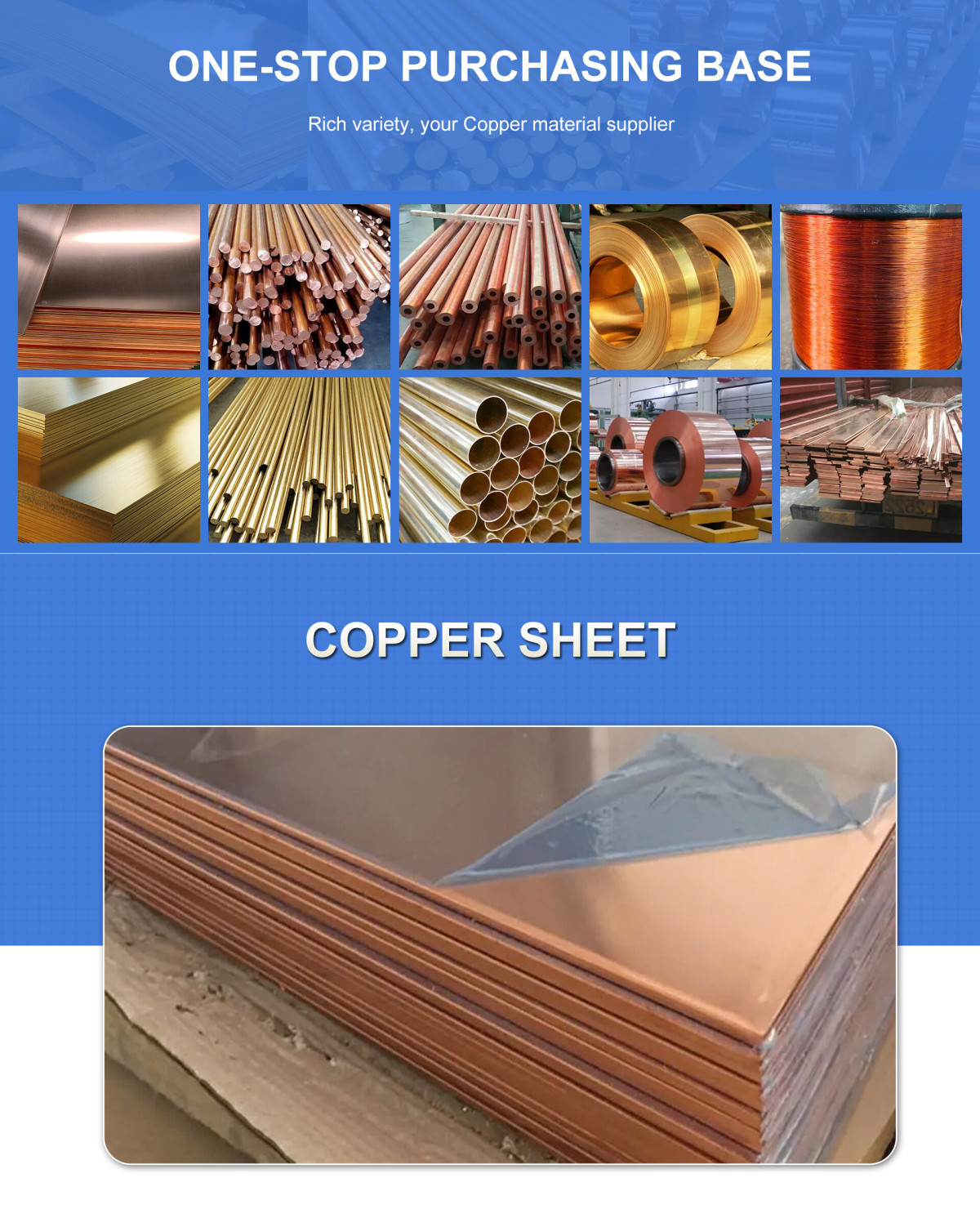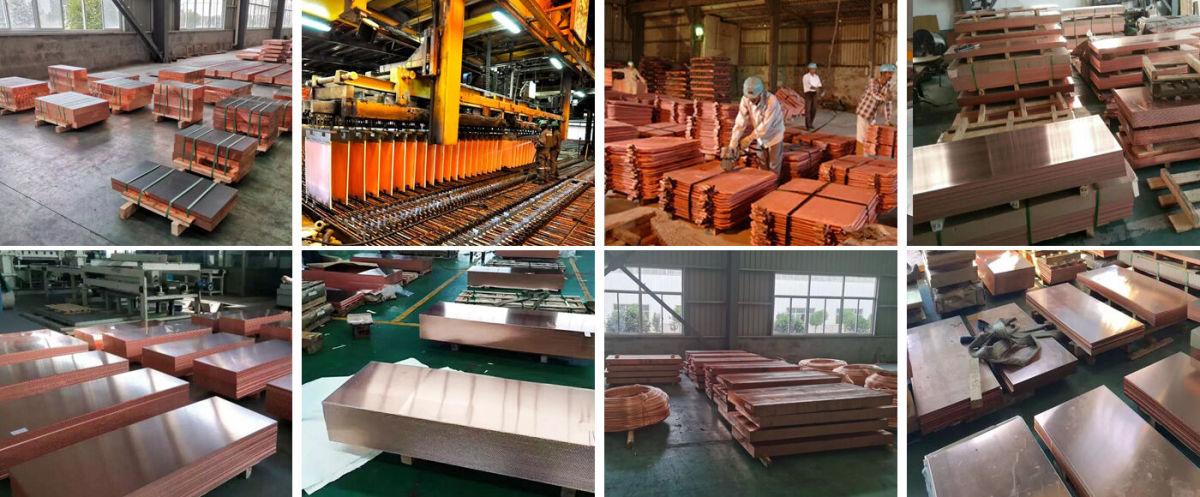
Detailed size range of C61900 copper plate According to industrial supply specifications, the size range of C61900 copper plate is as follows:
Description:
Conventional plates are supplied in the form of coils (thin plates), flat plates, and medium and thick plates, with surface conditions including pickling, polishing, etc.
Special sizes need to be customized according to the processing equipment capabilities and application scenarios, such as ultra-thin plates (0.1mm) for precision electronic components and ultra-thick plates (100mm) for heavy mechanical structures.
C61900 copper plate related international standards (for plates only)
The production and inspection of C61900 copper plates follow the following international standards:
1. ASTM B150/B150M
Scope of application: Chemical composition and mechanical properties of copper and copper alloy rolled plates, strips and bars.
Key parameters:
Tensile strength: ≥685 MPa
Elongation: ≥15%
Brinell hardness: ≥170 HB.
2. ASTM B248
Core content: Standardize the dimensional tolerance, surface quality and processing technology of copper alloy plates.
3. JIS H 3250
Supplementary requirements: Additional test methods and tolerance ranges for copper alloy bars and plates in Japanese industrial standards.
Note: Different standards may have specific requirements for heat treatment processes (such as annealing and normalizing), which need to be selected according to the application scenario
Chemical composition:
Copper (Cu): 83.6% to 88.5%, the main component of the alloy, provides good electrical and thermal conductivity.
Aluminum (Al): 8.5% to 10.0%, enhances the strength and corrosion resistance of the material.
Silver (Ag): 0.02% to 0.08%, further improves electrical conductivity and corrosion resistance.
Iron (Fe): 3.0% to 4.5%, improves the strength and hardness of the alloy.
Tin (Sn): ≤0.6%, improves wear resistance and processing performance.
Zinc (Zn): ≤0.8%, enhances toughness.
Lead (Pb): ≤0.02%, exists as an impurity and does not affect performance.
Mechanical properties:
Tensile strength: ≥585 MPa, indicating that it has high strength and is suitable for high stress environments.
Yield strength: ≥275 MPa, ensuring that the material is not prone to plastic deformation during use.
Elongation: ≥20%, indicating that the material has a certain ductility.
Fatigue strength: ≥180 MPa, suitable for high-frequency vibration or repeated load environments.
Hardness: Brinell hardness (HB) is about 170, indicating that it has high wear resistance and impact resistance.
Physical properties:
Density: about 8.79 g/cm³, close to the density of copper, but slightly lighter due to the addition of aluminum.
Thermal conductivity: about 56.5 W/m·K, with good thermal conductivity.
Melting point: lower than pure copper.
Processing performance:
C61900 aluminum bronze has excellent hot processing properties and is suitable for forging, extrusion, cold processing and other processes, which makes it perform well in the manufacture of gears, springs, bearings and other parts.

Production process and product advantages of C61900 copper plate:
1. Production process
Basic processing flow
Hot rolling and cold rolling: The production of copper plate strips usually adopts hot rolling and cold rolling processes. In the hot rolling stage, the plasticity is improved by heating the ingot (930°C solid solution treatment and water quenching), followed by multiple rolling; cold rolling further improves the dimensional accuracy and surface finish.
Annealing and pickling: Annealing is required after cold rolling to eliminate work hardening, and the surface oxide layer is removed by pickling to ensure the ductility and surface quality of the material.
Finishing: Including straightening, milling and other steps to meet the flatness and size requirements of the final product.
Surface treatment technology
Painting process: Some copper plates need to be degreased, washed, sprayed with primer/topcoat and dried to improve corrosion resistance and appearance performance.
Titanium plating carburizing modification: Plasma carburizing after magnetron sputtering titanium film can form a high hardness (more than 300 HV) wear-resistant layer on the surface, significantly reducing the wear rate (up to 90%).
Plasma nitriding: Thermal plasma nitriding is performed on the Cu-Ti gradient film to generate Ti-N compounds and AlCuTi intermetallic phases, improving surface hardness and wear resistance.
Application of advanced equipment
The use of equipment such as the Italian Mino six-roller cold finishing mill and the German Otto Junker annealing furnace ensures the high precision and consistency of the product.
2. Product advantages
Excellent mechanical properties
High strength and wear resistance: tensile strength of 685 MPa, Brinell hardness of 170 HB, and can be further increased to more than 300 HV through surface modification.
Excellent hot processing performance: good plasticity at high temperature, suitable for hot extrusion, forging and stamping.
Cold processing adaptability: cold rolling, bending and other processing can be carried out to meet the needs of complex parts manufacturing.
Outstanding corrosion resistance
High stability in the atmosphere, fresh water and seawater environments, good corrosion resistance to non-oxidizing acids (such as sulfuric acid), but alkaline environments must be avoided.
Electrical and thermal conductivity
The electrical conductivity is better than most alloys, with a thermal conductivity of 58.6 W/(m·K), suitable for electrical switches, contactors and other scenes that require high conductivity.
Economic and substitutable
Compared with tin bronze, stainless steel and other materials, the cost is lower and can replace some expensive alloys.
Special functional potential
It has shape memory effect and can be developed into shape memory alloys.
3. Application fields
Electrical engineering: springs, switch parts, conductive parts.
Mechanical manufacturing: bearings, gears, ship parts.
Aerospace and automobiles: high-stress structural parts and wear-resistant parts.
Q1:Do you provide samples? Is it free or extra?
A1:Yes, we can provide samples free of charge and the customer will pay the freight.
Q2:What if I don't have export experience ?
A2:We have reliable forwarder agent which can ship items to you by sea/air/Express to your doorstep. Any way, we will help you choose the most suitable shipping service.
Q3:How long is your lead time?
A3:If it is in stock, it is usually 5-10 days. Or, if there is no inventory, 15 days, depending on the quantity.
Q4:What are your terms of payment?
A4:30% T/T deposit in advance, 70% T/T balance within 5 days after B/L copy, 100%.Irrevocable L/C at sight, 100% Irrevocable L/C after receive B/L 30-120 days, O/A.
Q5:How is your technical support?
A5:We provide lifetime online support through Whatsapp/ Skype/ Wechat/ Email. Any problem after delivery, we will offer you call anytime.
Welcome To Your Inquiry
What can we help you?
RELATED PRODUCTS











